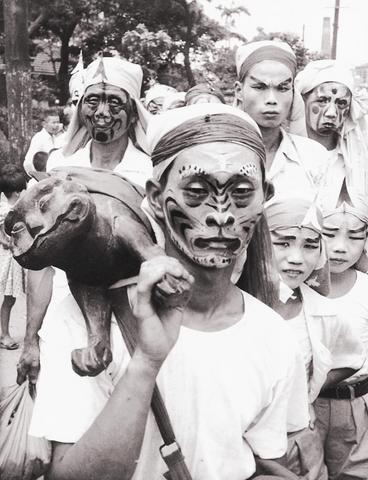"I am not highly educated. I just use my camera to observe people and things. It doesn't have to appear `artistic,'" was Chang Tsai's (張
The 71 works in Classic Chang Tsai -- the Unreleased Photos, (遺

PHOTO COURTESY OF TIVAC
A series of photos of egrets taken in Taipei's Guandu at sunset are the most beautiful works in the exhibition. According to Chang Tsai's son, the two set out from their home before every sunset and rode to the water front with their Leica and several makeshift lenses, which were unsuited for wildlife photography, and spent a good few hours patiently waiting for their subjects.
Chang always captured them in their most serene and confident posture against a background of amazingly geometrical tree branches. These small-format prints have acquired a sense of mystique over time, as flood water and moisture made white marks on the paper that look like passing clouds or reflections on rivers.
Tao Aborigines on Orchid Island are the subjects of another enduring series taken in the 1940s. At a time well before the commercialization of their pristine environment, Tao men and women let Chang record their daily life and take their portraits, sometimes in exchange for just a few Taiwan-made cigarettes. They look diligent yet contented with their lifestyle. A photo of a lone Tao man carrying a small pot of drinking water to his shed implies the Tao's easy-going attitude to life that is worlds away from the current tourism-driven islands.
Chang was one of the first generation of Taiwanese photographers with an academic background. At 18, Chang went to Tokyo to study photo portraiture. Five years later, he opened his photo studio in Taipei. In 1942, Chang and his newly-formed family went to do business in Shanghai. Chang's photgraphy career did not really take off until he returned to Taipei with his first solo exhibition in what is now Zhongshan Hall in Taipei. Since then, Chang has organized exhibitions and published photography journals in Taiwan and exhibited abroad.
His series of portraits of Tao Aborigines near Jade Mountain remains the highest-acclaimed. One of Chang's favorites from the series -- the imperturbable and dignified face of a Tao prince -- is also on show.
Classic Chang Tsai -- the Unreleased Photo Works, runs through Feb. 18 at Taiwan International Visual Arts Center, 29, Ln 45, Liaoning St, Taipei. (台

In the March 9 edition of the Taipei Times a piece by Ninon Godefroy ran with the headine “The quiet, gentle rhythm of Taiwan.” It started with the line “Taiwan is a small, humble place. There is no Eiffel Tower, no pyramids — no singular attraction that draws the world’s attention.” I laughed out loud at that. This was out of no disrespect for the author or the piece, which made some interesting analogies and good points about how both Din Tai Fung’s and Taiwan Semiconductor Manufacturing Co’s (TSMC, 台積電) meticulous attention to detail and quality are not quite up to

April 21 to April 27 Hsieh Er’s (謝娥) political fortunes were rising fast after she got out of jail and joined the Chinese Nationalist Party (KMT) in December 1945. Not only did she hold key positions in various committees, she was elected the only woman on the Taipei City Council and headed to Nanjing in 1946 as the sole Taiwanese female representative to the National Constituent Assembly. With the support of first lady Soong May-ling (宋美齡), she started the Taipei Women’s Association and Taiwan Provincial Women’s Association, where she

It is one of the more remarkable facts of Taiwan history that it was never occupied or claimed by any of the numerous kingdoms of southern China — Han or otherwise — that lay just across the water from it. None of their brilliant ministers ever discovered that Taiwan was a “core interest” of the state whose annexation was “inevitable.” As Paul Kua notes in an excellent monograph laying out how the Portuguese gave Taiwan the name “Formosa,” the first Europeans to express an interest in occupying Taiwan were the Spanish. Tonio Andrade in his seminal work, How Taiwan Became Chinese,

Mongolian influencer Anudari Daarya looks effortlessly glamorous and carefree in her social media posts — but the classically trained pianist’s road to acceptance as a transgender artist has been anything but easy. She is one of a growing number of Mongolian LGBTQ youth challenging stereotypes and fighting for acceptance through media representation in the socially conservative country. LGBTQ Mongolians often hide their identities from their employers and colleagues for fear of discrimination, with a survey by the non-profit LGBT Centre Mongolia showing that only 20 percent of people felt comfortable coming out at work. Daarya, 25, said she has faced discrimination since she